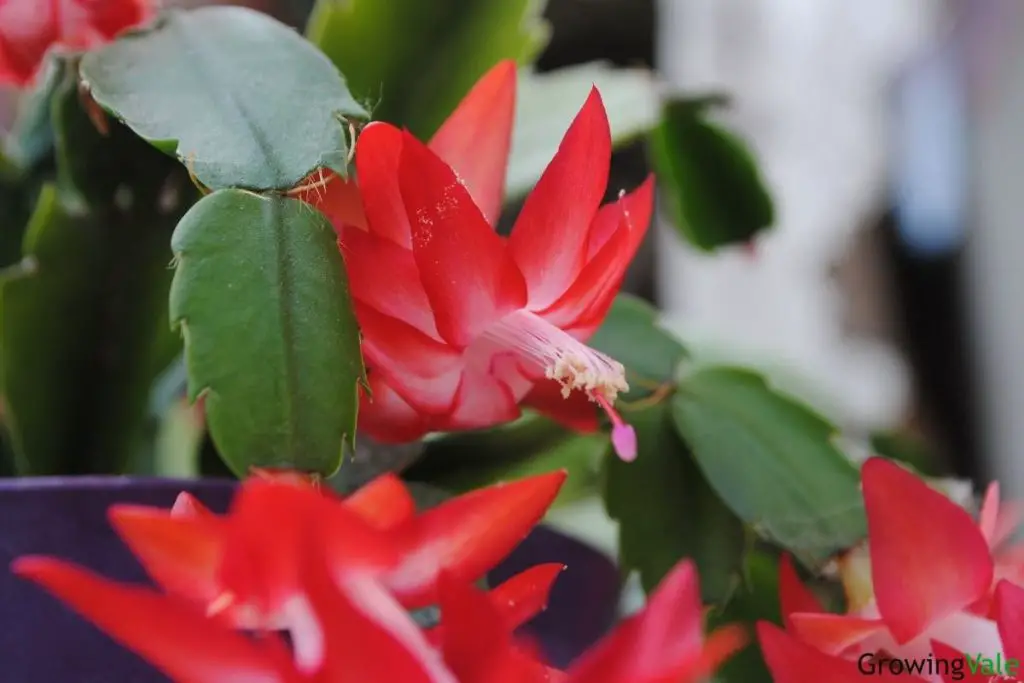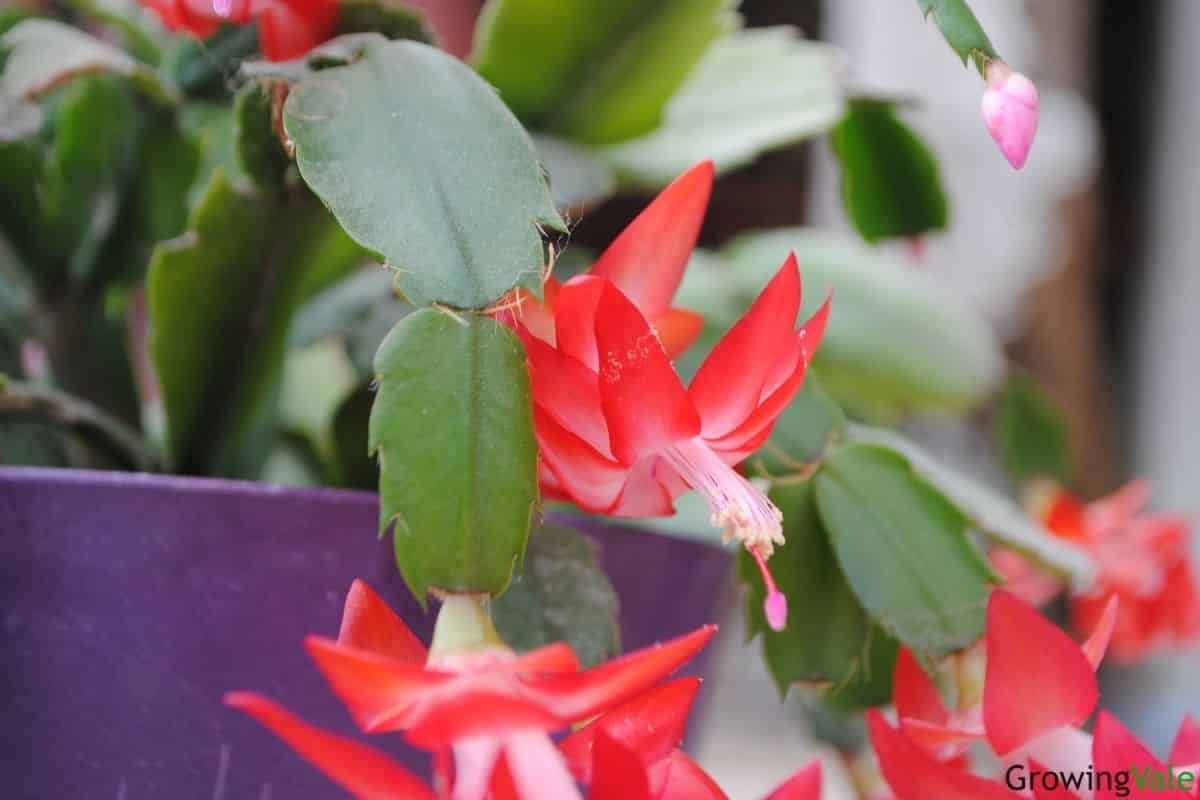Christmas cacti are easy plants to grow and can add a lot of color to your holiday decor as they bloom during the winter months. There are several species of Christmas cactus with a variety of different flower colors. These include white, red, pink, yellow, and purple.
The flowers will last for a number of weeks. This ensures that these cheery plants will brighten up even the coldest winter day. Due to their sprawling nature, these plants are also ideal for growing in hanging pots or baskets.
One thing that beginners should understand is that these plants prefer indirect light rather than direct sunlight. They do much better when they’re protected from too much sun. Plus, they also prefer a somewhat more humid environment than other species of cacti.
These plants are epiphytic succulents and in their natural environment will grow on tree branches in rainforest areas.
History
There’s an interesting legend that surrounds the Christmas cactus that comes from Brazil.
According to the legend, a little boy who was from a poor family was out in the jungle one day and prayed for a sign of Christmas. After many days had passed without an answer to his prayer, the boy woke up one morning and found himself surrounded by masses of beautiful flowers that had appeared on the cacti growing nearby. This resulted in the cactus being recognized as a symbol of answered prayers.
Plant Facts
| Scientific name | Schlumbergera spp. |
| Common names | Christmas cactus, Easter cactus, Thanksgiving cactus, Holiday cactus |
| Genus | Schlumbergera |
| Family | Cactaceae |
| Height | Up to 12 inches |
| Width | Up to 24 inches |
| USDA Plant Hardiness Zone | 10 to 12 |
| Origin | The tropical rainforest of Brazil |
| Flower colors | White, pink, red, yellow, orange, purple |
| Blooming season | Winter |
| Plant/Flower special features | Will flower in winter |
How to Plant and Grow Christmas Cactus
The stems of the holiday cactus have a tendency to cascade and sprawl over the edges of the container that the plant is growing in. This makes it ideal to grow these succulent plants in hanging planters.
As flowers are only borne on the end of each stem, the more stems that your plant has, the more flowers it can produce. Therefore, it’s a good idea to let the plant spread out as much as it wants to and hanging planters or baskets allow this to happen.
In saying that, the plant can also be grown in a normal pot as long as it has plenty of room to spread out. Also, make sure that the pot you choose has adequate drainage holes. Although this plant prefers more moisture than other cacti species, it still doesn’t like having wet feet so it must be given adequate drainage.

How to Propagate Christmas Cactus
Christmas cacti are extremely easy to propagate by simply using the stem sections that you’ve cut off while you were pruning your plant. When cutting off these stem sections, ensure that they’re around 3 to 4 inches long and have around 3 to 4 leaf sections.
Once you’ve taken your cuttings, place them in a cool, dry spot for around 3 to 4 days. This will allow the cut ends to callus over.
You can either propagate your cuttings in a seed-raising mix or in water. If using a seed-raising mix, plant your cuttings upright so that around 1 inch of the cutting is buried in the mix. Make sure you water these sparingly until you start to see new growth.
To propagate your cuttings in water, grab a glass jar and some pebbles. Fill the jar with the pebbles, around 2 inches deep. Pour some water into the jar to just cover the pebbles. Place your cuttings into the jar with just the bottom part touching the water. Add more water as it starts to evaporate.
Bear in mind that it may take 2 or 3 weeks for your cuttings to start producing roots. Once roots start to form in your water-propagated cactus, make sure that you transplant it into a pot with proper potting mix.
Care and Maintenance
Christmas cacti are actually quite easy to grow as long as you follow the advice outlined below.
Here are important christmas cactus care tips to follow.
Soil
You don’t have to use a specialized soil mix for the Christmas cactus. It will grow perfectly well in a normal potting mix that contains plenty of organic matter. Just ensure that the soil is free-draining and slightly on the acidic side. This plant prefers a soil pH of around 5.5 to 6.2.
Water
Christmas cacti do like a little more water than other species of cacti. You should water your plant whenever the top two-thirds of the soil feels dry. You can easily poke your finger into the soil to feel whether it’s dry or use a moisture meter to determine how much water is in the soil.
As a general guide, your plant will need watering every two to three weeks while it’s actively growing and maybe even more often while it’s flowering.
To water your plant correctly, wait till the top of the soil is dry and then thoroughly soak the plant until water runs out from the drainage holes. Wait around fifteen minutes and then remove the tray under the plant and discard any water that remains in it.
This will ensure that your plant doesn’t sit in water and will eliminate the problem of root rot.
Fertilizer
Like all flowering cactus plants, your Christmas cactus will benefit from some fertilizer during its active growth period. From spring to summer, you should give your plant some balanced liquid fertilizer about every two weeks.
In the fall and winter, you can reduce the fertilizing to around once a month. Your plant will still need some fertilizing during this period as it prepares to flower.
Sunlight
The Christmas cactus prefers to grow in partial shade. Too much sunlight will cause the stems to become yellow and pale. To promote good flowering though, the plant should get a little indirect bright light in the morning. An east-facing window is ideal for this as the plant will be protected from the harsh afternoon sun.
Temperature and Humidity
Because Christmas cacti originate from warm and humid rainforest regions, they do enjoy warmer temperatures and additional humidity. An ideal temperature range for these plants is between 70 to 60 degrees Fahrenheit (21 to 15 degrees Celsius).
Keeping your plant in a nice, moist environment like the bathroom or kitchen will ensure that it grows well and thrives. If the air in your home is a little dry, you can also supply the plant with some additional humidity by spraying it with water on very warm days or by installing a humidifier.
In the warmer weather, you can even place your plant outdoors on the porch or patio. Make sure though that you choose a shady spot that doesn’t get any direct sunlight.
Pruning
To make your Christmas cactus bushier and to encourage the growth of additional stems and more flowers, you should prune your plant in late spring. To do this, all you have to do is cut off a few sections from each stem. This will cause the plant to branch and produce an additional two stems from where you made the cut.
Don’t discard the cut-off pieces though because you can use them to easily propagate new plants to give away to your friends and family.
Pest and diseases
Christmas cacti are fairly hardy and don’t suffer too many problems. However, here are a few things to watch out for.
- Blossom Drop – If the plant is under any sort of stress, it may drop its blossoms before the flowers are fully opened. This could be due to not receiving enough water, a sudden change in temperature, or too much or too little light. During the formation of the flower buds, it’s important not to let your plant dry out too much.
- Mealybugs – These annoying little sap-sucking insects can easily be controlled by dabbing them with a cotton swab dipped in a mixture of water and isopropyl alcohol.
- Root Rot – Like all cacti and succulents, the roots of the Christmas cactus don’t like sitting in water. So, if they do, the plant is likely to be infected with root rot. If this has happened to your plant, remove it from the pot and cut off the affected roots. Then, repot the plant into some clean potting mix and continue to monitor it closely.
Uses of Christmas Cactus
Christmas cacti are grown for their ornamental value and for the lovely flowers they produce during the colder months. Their flowering is triggered by the colder weather and shorter days.
Here are some things that you can do to encourage your plant to produce more blooms:
- Don’t expose your plant to too much artificial light. It needs around 14 hours of dark and around 8 to 10 hours of daylight to trigger the blooming. Therefore, if you have bright lights on inside your home for long periods, move your plant to an area where it can receive more hours of darkness.
- Your Christmas cactus will start to produce flower buds when temperatures are around 50 to 60 degrees Fahrenheit (10 to 15 degrees Celsius). You can even trick your plant into producing buds by exposing it to nighttime temperatures of around 45 degrees Fahrenheit (7 degrees Celsius) for a number of nights in a row.
- Once you see some flower buds start to form, move your cactus near a bright window where it will get some indirect morning sun. Keep your plant away from drafts to ensure that it doesn’t drop its blossoms.
Common Varieties and Cultivars
There are a few different varieties of Christmas cacti that you can add to your collection. Although, some of these Schlumbergera varieties may not be readily available.
- Schlumbergera truncata (also commonly called Thanksgiving cactus)
- Schlumbergera x buckleyi
- Schlumbergera gaertneri (also commonly called Easter cactus)
- Schlumbergera russelliana
- Schlumbergera kautskyi
- Schlumbergera opuntioides
- Schlumbergera orssichiana
- Schlumbergera microsphaerica
Conclusion
The Christmas cactus is a lovely, easy cactus plant to grow, even for beginners. It doesn’t require any specialized care and can tolerate a little more water and humidity than other cacti species. It’s a very popular plant that many people grow during the holidays for its colorful and cheery flowers.

